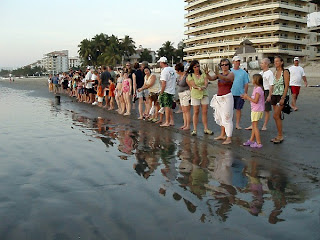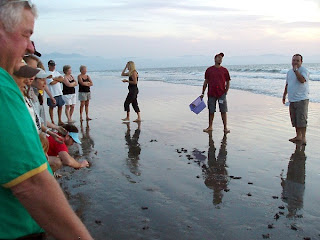
Since we discovered the turtle conservation preserve, it became our sunset activity to visit it every evening, gladly donating 20 pesos (2 Canadian dollars) each to the program.
The evening before we were due to leave Nuevo Vallarta, the biologist mentioned that the rare leatherback babies were hatching and they would be expecting them to make their appearance Saturday morning. It had been nine years since the last leatherback nested on the beach! He was brimming over with excitement and his enthusiasm spilled over to the crowd gathered at the site. We could hardly contain our excitement but we didn't know if we would be able to attend, given that we had to check out of our resort by noon if we could not obtain an extension and we were supposed to depart late Saturday night.
Fortunately, we were able to extend our stay so we set off just before sunset to get a glimpse of the precious and endangered baby turtlebacks.

Journalists and press photographers and TV crews were present to record this rare event and a large crowd had gathered and stood along the boundary line marked in the sand. Baby Olive Ridley turtles were already making their way to sea when we arrived. The biologist had decided to release them a little earlier in order to release the leatherbacks at sunset.
The leatherback is the champion among sea turtles. It grows larger, dives deeper, travels farther, and frequents colder waters than any other sea turtle. An adult leatherback is enormous, averaging 800 lbs and 64 inches in shell size. The largest leatherback ever recorded measured almost 10 ft! In comparison, the Olive Ridley is known as the "little one" because it is the smallest sea turtle, adults typically weighing less than 100 lbs and measuring only 22-30 in in shell size.
Unlike other sea turtles, leatherbacks do not have hard shells nor do they have scales and claws on their flippers. Its carapace (shell) is covered by skin and oily flesh. Hatchlings are 2.5 in long, compared to Olive Ridley hatchlings, which are 1 - 1.5 in long.
Leatherbacks travel from nesting beaches in the tropics to feeding grounds in temperate waters. The migration to their feeding grounds often involve journeys of more than 3,000 miles from their nesting beaches. The average nest contains 80-90 eggs.
VIDEO: Leatherback hatchlings make their way to sea.












